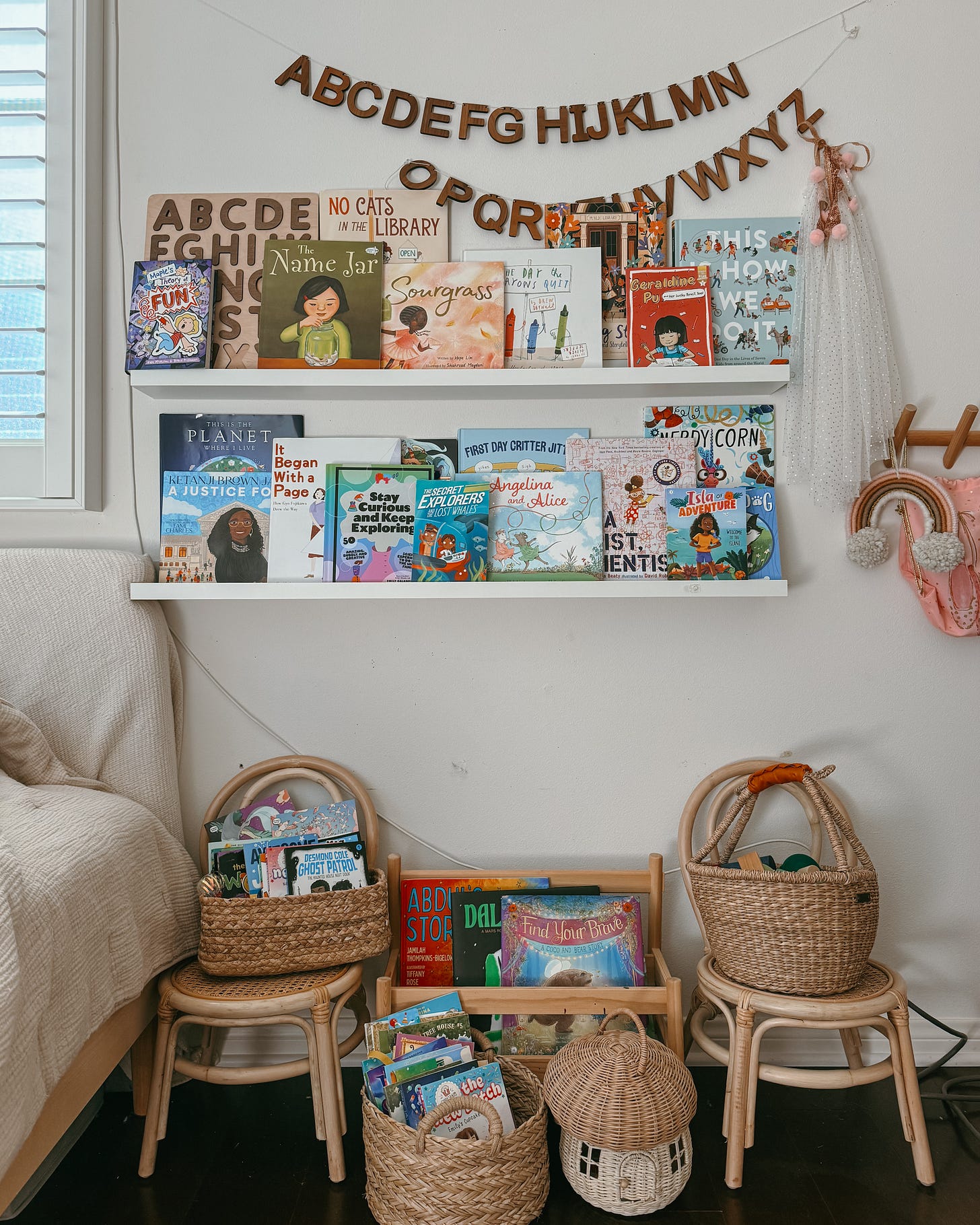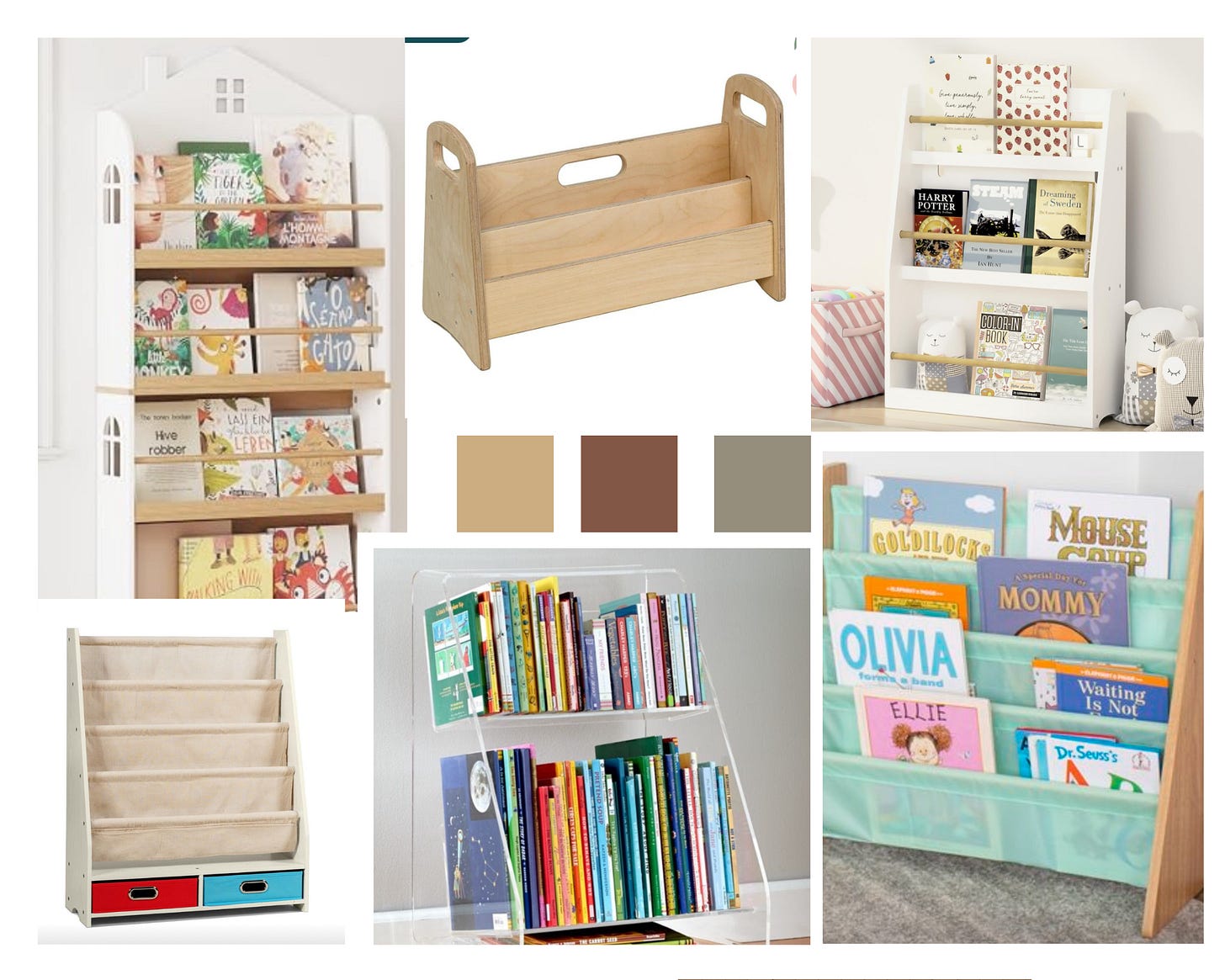Because you asked, here’s a purely anecdotal summary based on zero research of how I got my kids to enjoy reading as much as any other down time activity. Informally sponsored by the “Center For Kids Who Can’t Read Good” (just kidding).
From Baby to Toddler
When our eldest was born, we heard a PSA from First 5 California about the importance of reading and the “word gap” study. We knew we had to make make it a priority to add reading as a part of our consistent routine. Later research found that young children who were read to daily were exposed to at least 290,000 more words by the time they enter kindergarten than kids who aren’t read to regularly. That’s astonishing.
The routine: Read daily. It sounds easy enough, but as your children grow, your routine changes over time, but you must learn to be flexible without compromising daily reading. Don’t stress yourself out about what you’re reading or how much you’re reading. Focus on day-to-day consistency. And while it sounds aspirational, trust me when I say you don’t want to get stuck with a bedtime routine of 5+ books anyways because eventually those books will get longer and longer…
Asides from actually finding time for that consistent routine, the second hurdle is the baby/toddler who is completely disinterested in listening to the bedtime read. Guess what? Read anyways. Read while they’re in the bath. Read while they’re chasing and playing with toys. Read while they’re wandering around the room. Read while changing diapers or putting on pajamas. Read while they’re playing with a quiet activity. Those 290,000 words? They’re hearing it.
Book choices? At the baby age, this is probably your best window to read the widest range of diverse subjects while they don’t have much choice opinion. I truly think they’re absorbing even if they’re focused on something else. So, choose what you like, and pick a few board books with cute sounds and funny noises.
From toddler and on, encouraging reading shifts focus to: Access, Accessibility, then Content/Subject/Interest.
Access
Physical Access. Can they physically they choose books they want to read off the shelf? Can they see the covers of the books or are they only looking at book spines? Can they feel the books? Examples:
A floor/low basket of board books.
A floor/low of easy reader books.
A floor/low pull out crate of chapter books.
Picture book ledge (covers facing out). These are common as well.
Low shelve with covers facing out.
At this age, they likely are not going reading book spines to pick a book know that spine-out books.
Accessibility
Now that your child has physical access to the books, are they accessible (ie. reading level, comprehension?)
Examples: Are the board books easy to open on their own? Are the compilation story books too heavy for them to take off the shelf and hold on their own? (ie. 5 minute bedtime story books are great family reads, but they’re heavy and not for self readers. Same goes for Elephant and Piggie multi-volume books.) Keep those in family-read areas and not as a ‘self-reading’ choice.
Have you read the books before together? Are the books at the correct reading level? Does your child feel supported when reading? Do they avoid certain books because they can’t read it themselves? Do they avoid certain books because they have no idea what it’s about?
Family-read books can be shelved together or separately but you may want to rotate these more frequently if they’re not being self-read or picked off the shelf. It’s using up space for another book that might give more intrigue and self-reading opportunities. Keeping one book that seems like a ‘stretch’ of abilities is great to challenge a reader who is already interested in the topic (leave it in!) but can deter less than confident ones if the topic is not on point (take it out!).
Interest
It’s more about providing intrigue and diversity in topics. Making sure the books seem interesting enough for your child to want to pick up the book to explore. Book rotations are an easy way to gauge interest. Use it to display different ideas and subjects/topics to see what your child tends to pick up.
Timing of a book rotation isn’t a concern. Don’t get too caught up in rotation too often but do use it as a tool to introduce “new” and remove “untouched.” Rotation can be anywhere from monthly, quarterly, or seasonally. I usually stick to seasonally or by themes, but have definitely gone longer without a rotation. A good rotation with ‘new’ books will always bring a bit of interest back into play. Library books are great to rotate too - their due dates force you to rotate more regularly if you’re forgetting.
Don’t fall into the trap of ‘coffee table’ book display. Yes, aesthetic books are beautiful to display. There are also beautifully written books that make you cry because of their story, their prose, or their lessons are wonderful. Award winning books are aspirational. But, all of the above might still not intrigue your kids to read. I think first and foremost is finding books they would enjoy reading themselves and THEN scattering in the award winning, diverse content, & aesthetically beautiful books in the mix. The most important aspect of whether the books you choose are interesting is whether your child will find it interesting. Choosing book subjects:
Books on topics they’ve already shown interest in: Science, Fantasy, Sports, Movie franchises (Marvel, DC, Adventure, Magic (Heidi Heckelbeck and Henry Heckelbeck magic spells series), Mystery, Horror (very popular with the kids as much as you don’t want to admit it, K.R. Alexander is the new R. L Stine), Detective, Fantasy travel (Magic Treehouse), Animals (Critter Club, Magic Animals, Good Dog series).
Books on topics completely opposite of what you think they’d be interested in.
Books they don’t think you will let them read. If it’s age appropriate, why not?
Go to the library and browse the return racks.
Go to the library and browse the new releases or popular shelves.
Diversity in Book Types
There’s a misconception that “picture books are for babies”. If your kids are older and you’ve taken away all the picture books because your kids “should be reading chapter books by now”, you may have done yourself a disservice. There are picture books for many grade levels, and I think they’re important even for adults. Likewise, be open to graphic novels or books with diary-style entry.
Model Reading
Honestly, it’s just that straightforward. Have family reading time. Even when they’re doing homework or having screen time, I ask to sit next to them and read. The more they see me reading, the more they’ve become interested in reading. Be excited about books you’ve read that you want to share with them. Ask about books they’re reading.
Suggestions:
Some of our current favorite options* by reading level: (ages 4-12)
Easy Reader graphic novels
Nugget and Dog / Pizza and Taco
Pete the Cat
Graphic Novels (Age 4-7)
Dragons of Wrenly
Peanuts
Funny books
Grumpy Monkey
The Book With No Pictures
My Weird School
Bear and Rabbit
Ivy and Bean (Series)
Realistically Relatable Fiction Books
Junie B Jones
Heidi Heckelback / Henry Heckelbeck gets a Dragon Owl Diaries
Ramona and Beezus series (always available at library)
Henry Huggins
Diary of a Wimpy Kid / Dork Diaries
Odder
Chapter Books (Age 4-7)
Chapter Books (Age 8-12)
City of Ember
Spy School (Series)
Wings of Fire (Also comes in graphic novel form)
Graphic Novels / Comics (7+)
Wings of Fire (Available at Costco)
Guts / Smile / Sisters
Babysitter’s Club
American Born Chinese
Bone, Avatar, and Amulet
Let me know if you want me to expand on anything stated here. I love to provide suggestions based on interest and age group. I hope to add some paid content which will curated book lists for you based on your child’s interest and age via DM/Comments. If that’s something you’d be interested in, let me know in the comments.
Shop McCoy has great book options and is one of my favorite small shops. Using this link* will get you 10% off your order.
*Commissionable/affiliate link.






I am a high school English teacher (and taught elementary for a few years before that) and the mom of a ten-year-old boy, so this is a topic dear and to me! My son is a huge reader, thank goodness, I think due to seeing me read, me reading to him since day one (literally, I was reading Lolita in the hospital aloud to try to stay awake while feeding him), and accessibility (we have a very print-rich household). I've also tried to weave it into outings- we will take our books to a coffee shop to read together, have a "park reading date" (usually at Irvine Regional!), and I often host "reading nights" past his bedtime on Fridays in my room. I want it to be then norm, but also special!